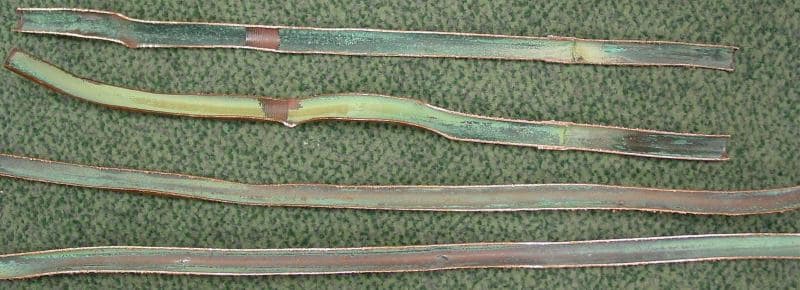
-----
Corrosion in new copper water heater
I am doing failure analysis study on copper tube corrosion. I got uniformly corroded copper tube with pin hole leaks in some locations from a hot water heater. This hot water heater is one year old and copper tube is 30 years old. I actually collected water sample from hot water tank outlet and also ordinary tap water from same household. I found water heater water alkalinity, conductivity, pH, and turbidity as 123 mg/L,372,7.6 & 1.75 NTU respectively and for tap water 53 mg/L,367,7.3,0.06 NTU. Does this elevated alkalinity and pH say anything about the copper corrosion. What puzzles me that the water heater is relatively new.I tested elemental composition of copper tube itself. It has 99.96 % copper, 0.025% Fe,. Do anyone have more idea about what's more needs to be done for solving the puzzle.
Thanx
Vinu VarughesePhiladelphia Water Dept - Philadelphia, Pennsylvania
2005
There is an excellent overview of copper corrosion in plumbing written by RJ Oliphant and it is available as a pdf. file at www.fwr.org/copper or by searching the keywords. There are at least four types of copper corrosion in potable water systems, but since the system is hot water, this eliminates a couple of them. Type 2 corrosion is the most popular one in the USA, although it may not be the most common! You do not actually say where the corrosion occurs - it could be simple erosion, especially if it is on a bend and the water has high particulate levels. Perhaps if you can give more information about the failure and its location, then a more positive response can be given. Remember, a picture paints a thousand words.....

Trevor Crichton
R&D practical scientist
Chesham, Bucks, UK
2005
2005
Thanks for the reply. Most of the corrosion takes place on the horizontal run copper tube from hot water heater.I am attaching the picture of this copper tube cut open. It looks like general corrosion and this usually occur due to water quality. General tap water pH is 7.3 and I collected hot water sample from three different household with old water heater and pH found to be higher even one reading was 8. I am trying to correlate some relationship with this high pH and copper tube corrosion. The household in which we got the copper tube also give us a strange reading even with a new water heater.(They replace the water heater one year ago, not copper tube). tap water pH is 7.3 and water heater pH is 7.6. I was trying to prove that with old water heater pH of water changes which causes copper tube corrosion.Thanks for trying to help me.
Vinu Varughese- Philadelphia, Pennsylvania

I would not be worried about the slight differences in pH you are experiencing. I would expect the pH to go up, especially if the water is hotter, as gases are less soluble in hot water than cold; hence you could be losing carbon dioxide, which will make the water less acidic (loss of carbolic acid). The pipe sectioning is well done and does indeed show general corrosion, very similar to what I have seen in the past. However, there is no clear picture of the inside of the tube where a failure has occurred. If you have got one, it would be very useful. Perhaps a high resolution digital picture that has been magnified will show something of use.

Trevor Crichton
R&D practical scientist
Chesham, Bucks, UK
2005
I tested the corrosion deposit by scraping the deposits from the inside surface and I got following composition. Al 2.5%, Ca 0.55 %, Cu 41.34 % Fe 1.12%, Mg 0.23 %, Mn 0.056 %, P 3.5%, Pb 1.11%, Sn 0.2%, Zn 3.28%. I understand that the copper corrosion is mainly either due the presence of flux (lead or tin) or by Aluminum solids. Does these results shows any significant amount for assuming that this corrosion is due to the presence of these elements ?. I talked about pH since AWWRF says that the water pH outside 6-8 range causes corrosion.
Vinu Varughese- Philadelphia, Pennsylvania
2005
Hi, I work for a coil producing plant in OK, and have had some issues with steam distribution coils. Recently I have had some coils coming back with pin leaks. After cutting the coils apart we found corrosion in the copper tubing. Almost identical to the pictures you guys have provided. I know our steam distribution coils mostly have 5/8's copper tube inside of a 1 inch copper tube. Right where the steam exits the 5/8's tube hitting the 1 inch tube that is cold, a pinhole forms. In dealing with these claims, I have been educating myself on contamination in steam. How would I go about testing and proving what exactly this is.
Daniel Lyons- Tahlequah, Oklahoma
2007
Just because the pH levels are normal, it does not mean the water is not corrosive. Check the Langliers index for the water, both cold and hot.
Martin Malek- Saddle River, New Jersey
February 12, 2010
Q, A, or Comment on THIS thread -or- Start a NEW Thread